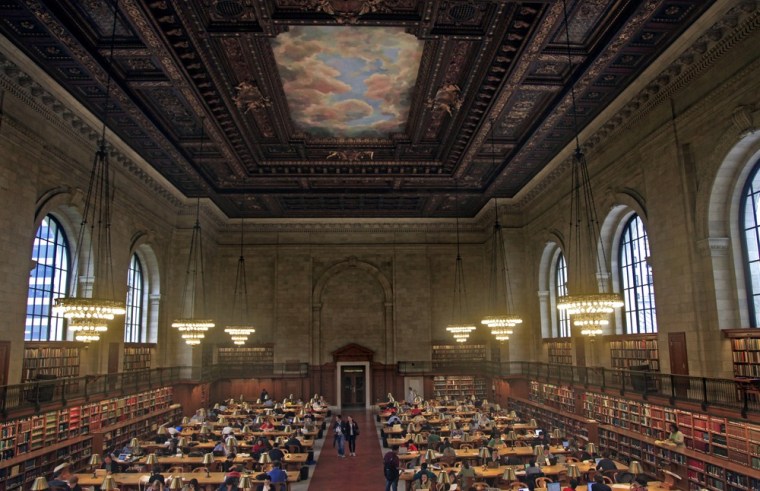At 100, the New York Public Library's landmark Fifth Avenue building has nurtured generations of scholars and boasts treasures like a Gutenberg Bible and an early copy of the Declaration of Independence.
But while its stacks house millions of physical books, the library's push to embrace 21st century technology includes a new digital publication available as an iPad app.
"Books are important to us," library President Paul LeClerc said in an interview. "And online is important to us. And we're not abandoning either one."
The New York Public Library was founded at the close of the 19th century by merging libraries built by wealthy New Yorkers James Lenox and John Jacob Astor. The current library system comprises some 90 research libraries and branch libraries. Its collections total more than 50 million items, including more than 20 million books.
The flagship is the Stephen A. Schwarzman Building at Fifth Avenue and 42nd Street, which opened on May 23, 1911. Guarded by lions Patience and Fortitude, it is one of the city's most recognizable structures. A $50 million restoration undertaken to prepare for the centennial removed decades of grime from the gleaming marble facade.
The library operates with both public and private funds, and cutbacks in city funding may force neighborhood branch libraries to reduce their hours. The main library has benefited from many private donations, and facilities such as the Bill Blass Public Catalog Room bear the donors' names.
Birthday festivities over the weekend included tours of the normally off-limits stacks and the unveiling of Lego replicas of Patience and Fortitude. An overnight scavenger hunt Friday was partially inspired by "A Night at the Museum." Five hundred people spent the night at the library using a smartphone app to search for artifacts such as the cane found after Virginia Woolf drowned herself and the taxidermied paw of Charles Dickens' cat.
For the centennial gala Monday, LeClerc said lighting designers will make the library "more beautiful than any building in Paris at night."
A centennial exhibit runs through Dec. 31 and offers highlights of the collection like a copy of the Declaration of Independence handwritten by Thomas Jefferson and Malcolm X's journal. (Both men had excellent penmanship.)
Upstairs in the Rose Main Reading Room, about the size of a football field, the silence is broken by the buzz of laptops booting up. Visitors without a laptop can borrow one with a library card and use it in the Edna Barnes Salomon Room, watched over by portraits of notables including George Washington and John Milton.
Juxtapositions of old and new can be jarring. Though it welcomes computers, the reading room's walls are lined with pre-Internet reference works like the Readers' Guide to Periodical Literature. LeClerc said the library will keep the Readers' Guide, though all the information is available online.
The birthday bash is part of LeClerc's farewell tour; he is stepping down at the end of June after heading the library for 17½ years.
"The challenges of being at the library at this point were really fascinating," he said. "We rode the wave of the digital revolution like surfers."
The library created a website in 1995 and converted its printed catalog — 800 folio-sized volumes — into web-accessible formats. "The A's along take up 53 stout, big volumes," LeClerc said.
Since 2005, the NYPL Digital Gallery has made half a million images of objects in the library's holdings available for downloading. LeClerc noted that Yale University only put its library of digital images online this month.
And the NYPL was one of five original partners of Google Books, which puts snippets of books online or the entire book if the work is in the public domain.
LeClerc is particularly excited by the iPad app, Biblion, which, according to his staff, "seeks to offer a new reading experience based on personalized journeys through the library's stacks."
While such efforts have made the library accessible to a global audience, scholars who have worked at the Fifth Avenue building cherish the camaraderie of the physical edifice as well as the breadth of its holdings.
"It's great because of the books they have there," said Robert Caro, the Pulitzer Prize-winning author of "The Power Broker," his influential 1974 biography of master builder Robert Moses, and a multivolume biography of President Lyndon Johnson. "But it's great because of the books that have been written there."
As he worked on "The Power Broker," Caro applied and was accepted to the library's Frederick Lewis Allen Memorial Room, open to writers with a book contract, joining "this little community of writers."
Caro became friends with Allen Room denizens Barbara Tuchman and Joseph P. Lash, both "idols" of his, while delving into the library's cache of Moses materials.
"I always think of it as home," he said.
Another Pulitzer winner for biography, T.J. Stiles, tells a similar story.
Stiles won the 2010 prize for his book "The First Tycoon: The Epic Life of Cornelius Vanderbilt"; he is now working on a book about George Armstrong Custer. He wrote the Vanderbilt book with help from a fellowship at the NYPL's Dorothy and Lewis B. Cullman Center for Scholars and Writers. Other fellows included the novelists Jennifer Egan and Colum McCann, who provided "invaluable" input, Stiles said.
"It would have been very difficult for me to launch my career as a serious biographer without the New York Public Library" said Stiles, who lives in San Francisco now but makes research trips to New York to use the library.
Chicago resident Alice Brand, also a former New Yorker, visited the library last week. As a high school student in the 1950s, she went there to research a paper on the history of the potter's wheel.
"It's so overwhelming," she said. "It's a building to worship."
